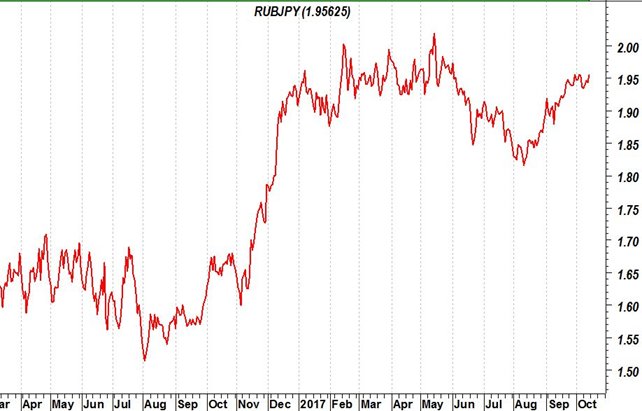The Forex market allows each trader to operate not only on major currencies like EurUsd, UsdJpy or GbpUsd (the so-called majors), but also on the so-called exotic cross currencies.
Although in the business world exotic crosses (i.e. RubJpy) are not often used, some online trading platforms artificially create crosses, namely RubJpy, which allow the trader to generate a synthetic change with a potentially explosive volatility.
The cross is generated by the intersection of the most common and liquid UsdRub and UsdJpy; the trader who wants to bet on the synthetic change RubJ py should first correctly interpret the graph of the two original exchange rates and then choose a trading platform and a long or short operation on RubJpy.

Since this is an artificial cross, the liquidity is a key factor when a trader decides to operate with this underlying asset. UsdRub or UsdJpy, though, with a more or less intense time related to the geographical location, still have a fairly high liquidity that allows the trader to get a good bid ask spread. If we think about RubJpy, the trader can expect a much wider spread, as well as the fact that the times with the most liquidity of the Russian Ruble and the Japanese Jpy are completely different.
Trading hours for exchange rates
Business times are a fundamental variable when a trader decides to trade on forex. It is true that financial markets are always open, but it is quite different to operate on EurNok for an European trader and on AudNzd at the same time of the day. Clearly, the bid ask spread offered on AudNzd at 10am GMT on the platform managed by the broker will be much higher than EurNok. Furthermore, the volatility is another factor to be added.
If we observe the trend of the EurNok cross during a normal European morning, we will notice how the output of macroeconomic data in the Euro zone or in Norway can change the cross trend very quickly; vice versa for AudNzd we cannot expect big moves as most of the economic information or central banker statements have occurred during the European night.
That’s why it is wise to always place orders with price levels already set at startup. In practice, the trader, after studying the cross chart of AudNzd and the scheduled event calendar will have to enter a long or short entry level with a stop loss and a possible take profit.
But why is this activity necessary? It is necessary above all to avoid (or take advantage of) dangerous price spikes that, during the night, when the trader is completely absent, may alter the validity of the transaction.
Through a proper use of money management, the European trader can also operate on exotic crosses outside of normal trading hours, limiting the risk. Although rich in opportunities, it should always be remembered that these crosses have huge indirect costs for the customer due to spreads – a factor that even in the best hours of the day is likely to significantly reduce the potential earning.



